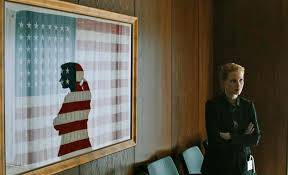Watching the whistleblowers: two new spy films tailor-made for an age of paranoia

Nick Wall/IFC Films
Catherine Edwards, University of York
The revelations surrounding US president Donald Trump’s telephone conversation with the president of Ukraine, Volodymyr Zelenskyy, are raising serious questions about attempts to solicit outside interference in US domestic affairs. The erupting impeachment scandal has placed whistleblowers firmly back on the international agenda.
In a scene from director Gavin Hood’s 2019 film Official Secrets, journalist Martin Bright (Matt Smith) meets a source in an underground car park. “Very Deep Throat,” he comments drily, referencing the famous source in the 1970s Watergate conspiracy that brought down then US president, Richard Nixon. His informant holds up her mobile phone: “No signal,” she replies, indicating the real reason for her choice of location.
In a single moment, the film – which is set in 2003 – both acknowledges its generic heritage and positions itself in the technological context of early 21st-century spycraft. The pervasive fear of surveillance has been updated for the digital age.
Official Secrets is the first of two films released in the UK in autumn 2019 that reflect on the events that took place in the lead up to, and aftermath of, the 2003 Iraq War. It follows the decision of 27-year-old GCHQ translator Katharine Gun (Keira Knightley) to leak a memo that her employer received from the US National Security Agency (NSA) in January 2003.
The memo asked the British listening station for its cooperation in a US “surge” against selected members of the UN Security Council. The aim was to gather material designed to influence voting intentions and secure a second resolution (ultimately unsuccessfully) in support of the Iraq War.
The film dramatises Gun’s journey from loyal civil servant to whistle
blower and court defendant, charting the personal and professional fall out of her actions as she finds herself pitted against the might of the British establishment – and its judicial wrath. In parallel, the film follows the painstaking processes of the investigative journalists (Martin Bright, Peter Beaumont and Ed Vulliamy) who broke the story.
Official Secrets offers a passionate and damning assessment of UK government collusion in a US dirty tricks campaign designed to sway international opinion in favour of the Iraq War. It champions the efforts of individuals who stand up for their moral principles, whether through whistleblowing, journalism, or legal activism.
While ostensibly commenting on these historical actions, the film also illuminates contemporary concerns about government secrecy, accountability, and factual manipulation.
In the UK, the alleged suppression of the Parliamentary Intelligence Security Committee (ISC) report into Russian covert activity recently prompted suspicions about what (if anything) the British government is hiding about external meddling.
The temporary brand switch of the Conservative Party Press Office Twitter account to “FactCheckUK” during the a debate of party leaders in the run up to a December general election provoked complaints about an act of deliberate deception designed to muddy the (already murky) waters of online discourse. By fictionalising historical attempts by the British government to manipulate the court of public opinion, Official Secrets invites parallels to be drawn with the current erosion of trust in the political elite.
Cover up
The second film released in November to chronicle historical efforts to hold officialdom to account is Scott Burns’ The Report. While also containing the near obligatory car park informant scene, The Report is an altogether darker, denser thriller. It follows US Senate assistant Dan Jones (Adam Driver) as he is assigned by the Senate Intelligence Committee to investigate the CIA’s programme of Enhanced Interrogation Techniques (EITs) during the post-9/11 War on Terror.
Enhanced interrogation, it is rapidly made clear, is a euphemism for torture. Waterboarding, sleep deprivation and cramped confinement (false burial) were among 16 techniques designed to break the resistance of terror suspects. With mounting intensity and moral purpose, Jones meticulously pieces together the stories of each of the 119 detainees, eventually producing a 6,700-page report (reduced to a 700-page executive summary).
Interspersed with flashbacks of dehumanising violence, the film charts Jones’ increasingly obsessional pursuit of the truth. It is uncompromising in its denunciation of the CIA as perpetrators of torture, and of the US government for authorising its use and colluding in the cover up.
The criticism, however, is not restricted to the Bush-Cheney regime. Also in the firing line is the hypocrisy of the Obama presidency (represented in the film by John Hamm as the White House chief of staff) who, it is suggested, was only too happy to reap the benefits of CIA propaganda when it came to the 2012 re-election campaign.
Real-life dramas
In a similar way to Official Secrets, The Report both dramatises an historical event and offers an implicit commentary on the current political climate in the Anglo-American sphere. By showing a recording of the actual speech given by the late John McCain on publication of the report, the film drags the recent past firmly into the present. It provides a glaring contrast between the bipartisan values that motivated the Senate investigation and the wilful disinformation that continues to emerge from the Trump administration.
In the present febrile political climate the tagline of The Report could be read as a clarion call to politicians on both sides of the pond: Truth Matters. If only they would listen.![]()
Catherine Edwards, Doctoral Researcher, University of York
This article is republished from The Conversation under a Creative Commons license. Read the original article.








